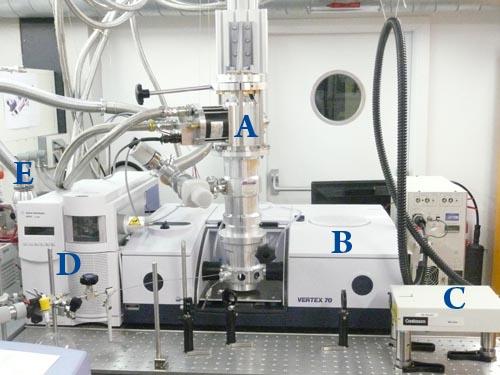Matrix-Isolation Spectroscopy
Matrix-Isolation Equipment: A. Closed-Cycle Cryocooler (4K), B. FTIR & UV/VIS Spectrometer, C. NdYAG-Laser for ablation, D. Mass Spectrometer, E. Oil diffusion pump
Introduction of matrix-isolation techniques
The matrix-isolation technique can be traced back to the early 20th century when Vegard bombarded condensed gases with electrons and observed the resulting luminescence. Many new developments have been introduced during the ensuing years and matrix-isolation spectroscopy is now established as one of the major methods used to investigate intermediates and new species.
In principle, matrix-isolation comprises a category of experimental techniques in which guest molecules or atoms are trapped in rigid host materials. Because the species are embedded in a host material, the diffusion process is prevented and bimolecular reactions cannot take place, except with the host material. Nevertheless small atoms like H and F can be mobilized even in rigid host materials. Several kinds of host materials exist, such as crystalline solids, polymers or glasses, which are formed during the freezing of the liquid or solidification of the gas phase.
After successful deposition of the matrix, the trapped guest species can be activated by irradiation and by low-temperature annealing. The new formed intermediates or species are than capable for spectroscopic measurements like IR, Raman, ESR etc..
Host materials for matrix-isolation spectroscopy
In principle, every substance that can be frozen is a potential host material for matrix-isolation experiments. Examples of common substances used are N2, CO2, SF6, N2O, CH4 etc.. All can be solidified at low temperatures but they have the disadvantage of giving rise to relatively strong interactions with the guest species.

Generalized matrix-isolation scheme. The rigid host lattice (shown as open circles) isolates molecules of a reactive species from each other and prevents bimolecular reaction.
The usual host materials which are known to have only minor interactions with the trapped guest species are solid noble gases (Ne, Ar, Kr, and Xe). These gases were first employed in matrix-isolation methodologies by G. Pimentel in 1954 and offer three main advantages:
• they form clear glasses,
• they show transparency through the IR, Vis, and UV regions of the spectrum,
• they are, for most guests, chemically inert.
In particular, neon and argon can be used as host materials to investigate high oxidation states. Their use is enhanced in view of the mobility of F atoms in solid argon, and even more so in solid neon.
Deposition of atoms or molecules
The matrix has to be formed by deposition from the gas-phase onto a cold window. It is therefore necessary to introduce any species or material which is to be trapped in the matrix via the gas-phase. There are three efficient ways of introducing transition metals into matrices of the proposed host gases:
a. If the guest has a high vapour pressure, such as mercury, or the guest has a moderate melting point, thermal methods can be employed to evaporate the atoms or molecules. This could be done by use of the Knudsen effusion method where the guest material can be heated up to several hundred degrees. The Knudsen cell can be heated by induction or by electron bombardment, and has been traditionally employed in matrix-isolation technology.
b. A second effective way for the evaporation of atoms or molecules is by the use of laser-ablation. Not only is the host material evaporated, there is often a additional quantity of cations and electrons that are ablated. One of the advantages of this method is that laser-ablated transition metals have excess kinetic/electronic energy which makes the atoms more reactive. Furthermore, refractory elements like tungsten can be evaporated with a laser producing a minimum of heat load on the sample because only a small area of the sample is heated at very high temperatures. Nevertheless, this has also a disadvantage because of the high temperature achieved during the ablation leads to some emission which can irradiate the sample.
c. The third way is by use of volatile compounds. The rate of evaporation of these species is controlled by external cooling or heating.
Overview:
Matrixisolation: Erzeugung und Nachweis reaktiver Moleküle,
H. Schnöckel, S. Schunck, Chem. unserer Zeit 1987 21, 73-81
Erzeugung und spektroskopische Untersuchung transienter Moleküle
G. M. Lask, R. Schlachta, V. E. Bondybey, , Chem. unserer Zeit 1994, 28, 241-252
The spectroscopy of molecular reaction intermediates trapped in solid rare gases
M. E. Jacox, Chem. Soc. 2002, 31, 108-115
Own selected research papers:
- Beyond Iron Trifluoride: A Matrix-Isolation and Quantum-Chemical Investigation of FeF4 Tobias Schlöder, Thomas Vent-Schmidt, Sebastian Riedel Angew. Chem. Int. Ed. 2012, 51, 12063–12067
- Formation and Characterization of HUF and DUF in Solid Argon Thomas Vent-Schmidt, Rodney Dale Hunt, Lester Andrews, Sebastian Riedel Chem. Comm. 2013, 49, 3863–3865
- Investigation of missing links in gold fluorine chemistry by matrix-isolation spectroscopy and quantum-chemical calculations Xuefeng Wang, Lester Andrews, Knut Willmann, Felix Brosi, Sebastian Riedel Angew. Chem. Int. Ed. 2012, 51, 10628–10632
- Investigation of Alkali Metal Polyfluorides by Matrix-isolation Spectroscopy Frenio A. Redeker, Helmut Beckers, Sebastian Riedel RSC Adv. 2015, 5, 106568-106573
- Oxygen radical character in group 11 oxygen fluorides Lin Li, Tony Stüker, Stefanie Kieninger, Dirk Andrae, Tobias Schlöder, Yu Gong, Lester Andrews, Helmut Beckers and Sebastian Riedel Nature Communication 2018, 9:1267
- Matrix-isolation and quantum-chemical analysis of C3v conformer of XeF6, XeOF4 and their acetonitrile adducts Maxim Gawrilow, Helmut Beckers, Lan Cheng, Sebastian Riedel J. Phys. Chem. A 2018, 122, 119-129

